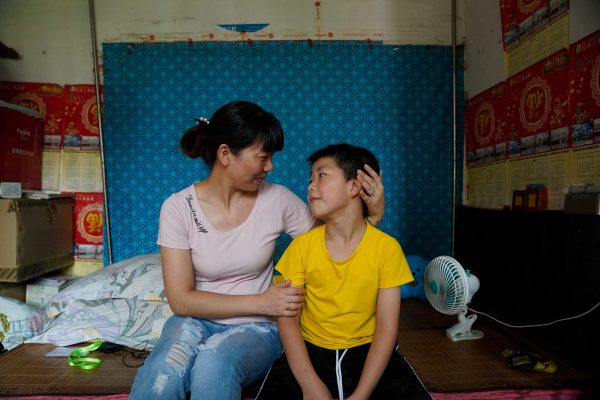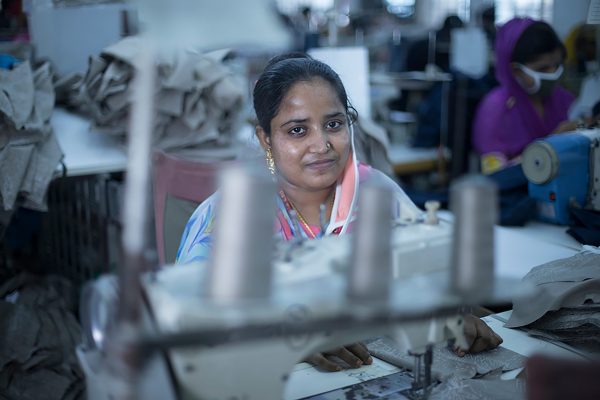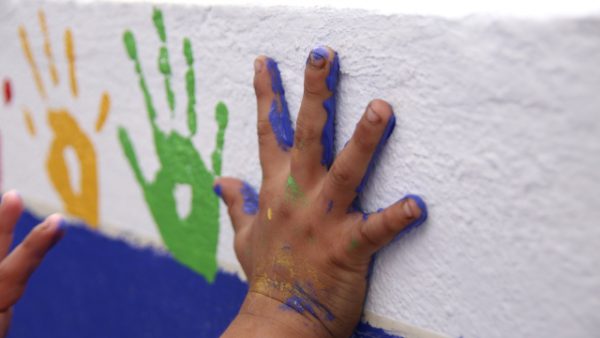Community and Environment
Children grow up in communities and environments that are impacted by business operations and supply chains.
Families live next to factories, mines and agricultural fields all of which produce air, water and land pollution that are especially harmful to children.
Children also live in areas with rampant conflict around valuable resources, including land, forests and rivers, and are particularly at risk of exploitation during conflict.
In this context, business has the responsibility and opportunity not only to ensure that operations and supply chains do not have adverse effects on children’s wellbeing, but also incorporate the voices of all affected – including children – to empower them and build sustainable communities.
 A Village, A Buyer and a Child-Friendly Space: A Human Rights Due Diligence Story from the Rattan Fields
A Village, A Buyer and a Child-Friendly Space: A Human Rights Due Diligence Story from the Rattan Fields
Ellen Schliebitz of The Centre for Child Rights and Business discusses The Child Friendly Space (CFS), and assessing child rights risks in the supply chain.
 Advocating for Children's Rights: A Smart Business Move
Advocating for Children's Rights: A Smart Business Move
Pia Gisgård and Kristin Wallander, from Swedbank Robur, on the importance of considering children’s rights as a business.
 International Day of Families: Empowering Climate Action through Business Support
International Day of Families: Empowering Climate Action through Business Support
The International Day of Families 2024 focuses on families and climate change. Global Child Forum explores how business can take action to support.
 Shaping tomorrow’s cities – the role of youth in urban design
Shaping tomorrow’s cities – the role of youth in urban design
Simon Weedy, Editor of Child in the City, on why a youth perspective is essential to the planning and development of urban living areas.
 Global Benchmark Report - The State of Children’s Rights and Business 2021
Global Benchmark Report - The State of Children’s Rights and Business 2021
Are companies prioritizing children’s rights among all the other issues on the sustainability agenda? Learn more from our Global Benchmark - The State of Children's Rights and Business 2021
 Wilmar’s Path Towards Responsible Sustainability Management
Wilmar’s Path Towards Responsible Sustainability Management
A study showcasing Wilmar’s path towards a more sustainable business, and how to integrate a child rights perspective.
 The State of Children's Rights and Business in Southeast Asia 2020
The State of Children's Rights and Business in Southeast Asia 2020
The State of Children's Rights and Business in Southeast Asia 2020
 A Watershed Moment for Business: The effects of COVID-19 young people
A Watershed Moment for Business: The effects of COVID-19 young people
Of all the heartbreaking effects of COVID-19, its impact on young people could prove to be one of its most damaging legacies. In fact, the coronavirus crisis risks turning back the clock on years of progress made on children’s well-being and has put children’s rights under serious pressure across the globe. Linda Lodding, Head of Communications at Global Child Forum, takes a closer look at these pressure points.
 Listening and learning: Top 10 children’s rights issues for business to consider
Listening and learning: Top 10 children’s rights issues for business to consider
To mark Global Child Forum’s ten-year anniversary, Désirée Abrahams asked both adults and children, what they considered the top 10 most important child right’s issues for business to consider in the next decade. In this blog post, she shares her reflections on the process and the survey’s findings
 Rethinking the rights of children for the internet age
Rethinking the rights of children for the internet age
Professor Sonia Livingstone explores the transformative effects of the internet on both children and wider society.
 Child Labour Policy: An integrated approach
Child Labour Policy: An integrated approach
The world has taken on the task to eliminate child labour. What are we doing wrong, and how can we finally make it a thing of the past?
 Children’s Voices - China story
Children’s Voices - China story
Watch the story of Rongxuan, whose mother left him behind with his grandparents so that she could return to work in Dongguan, China.
 Children’s Voices - Bangladesh story
Children’s Voices - Bangladesh story
Take a look at this film about Nadiya, and her mother Nasima Begum, who is a garment worker in Dhaka, Bangladesh.
 GoTeach: Building Bridges to a Brighter Future
GoTeach: Building Bridges to a Brighter Future
Deutsche Post DHL Group and SOS Children’s Villages have been partnering since 2011 in an initiative called GoTeach to help disadvantaged young people bridge the gap to the world of employment.
 Norsk Hydro Brazil’s journey towards social responsibility
Norsk Hydro Brazil’s journey towards social responsibility
This case study on Norsk Hydro Brazil and social responsibility shows how the company addresses children’s rights and related issues in its operations.
 Improving family life: How Chinese factories help workers, their children and their business
Improving family life: How Chinese factories help workers, their children and their business
“My husband and I came out to work for our children but we couldn’t take them with us. We don’t have the time to take care of them or to cook for them…so we left them with their grandparents,” said Liu Jing*, a factory worker whose three children live with their grandparents in a village in Hunan, China. She is part of the “247 million” – the number of people who have migrated for work in China. She has been a factory worker for the past ten years, and like many in her situation, only returns home a handful of times throughout the year to see her children. If her situation can be represented by a number, so can her children’s. They belong to the “61 million”, the estimated number of children in China who grow up without one or both parents present. Behind these numbers however, are stories far more intricate, stories that have implications not only for society but for businesses as well.
 CELESC: A multi-faceted approach to children’s rights
CELESC: A multi-faceted approach to children’s rights
CELESC is eliminating child labour in its supply chain through policies, contractual clauses, and other initiatives.
 Grupo Telecom: Protecting children online is all about education
Grupo Telecom: Protecting children online is all about education
This study on Grupo Telecom is part of our series looking at how companies find solutions to support children’s rights.
 “It's in everyone's reach to make a difference”:
“It's in everyone's reach to make a difference”: Q&A with social entrepreneur Carolina Medina
Selected as a UN Young Leader for the Sustainable Development Goals, Colombia’s Carolina Medina is, no doubt, goal-oriented. She wants to ensure that urban households have access to healthy and affordable food. A well-fed child, after all, has the opportunity to become well-educated child. Through her start-up, Agruppa, Medina is making this goal a reality – one “Mom and Pop” shop at a time.
 SCA: Recognising Children as Stakeholders
SCA: Recognising Children as Stakeholders
This case study details how SCA is recognising children as stakeholders and ensuring their rights are integrated into daily operations.
The private sector can profoundly impact social development. As such, businesses have a unique opportunity to act as agents of positive change for children and their rights. As the future mothers and fathers, employees and employers, customers, and boardroom leaders, children are business’s most valuable stakeholders. Long version: Short version: Children’s rights and business videos
 Toolkit Juara Child-Friendly Business: A guidance for business (hotel and restaurant) integrating children’s rights
Toolkit Juara Child-Friendly Business: A guidance for business (hotel and restaurant) integrating children’s rights
Together with the Indonesian Hotel and Restaurant Association (PHRI) in West Java, Save the Children has been integrating a child-centred corporate social responsibility project in the hospitality sector of Indonesia. The project worked to encourage members to integrate children’s rights into their member’s business operations and strategies. One result of the project was the creation of this toolkit, which included the assistance of academics, several NGOs, and input from child and youth participants. It consists of four tools for children’s rights integration and eight tools that inspire hotels and restaurants in responding to issues and problems that most frequently arise and impact children’s rights.
Children’s rights are an essential investment in a sustainable future. Safeguarding these rights helps build the strong, well-educated communities that are vital to creating stable, inclusive and productive societies. The private sector impacts children’s lives both directly and indirectly, and all companies in all industries – global, regional or local – can make a difference. Business activity influences the daily life of children in a number of ways, from impoverished communities where children are held back from getting an education because they need to support the family with their income, to the marketplace where children react to marketing messages and learn about the world via the many products surrounding them. Companies that want to take part in the movement pushing sustainable development forward, creating the world that we together have formulated in the Sustainable Development Goals and Agenda 2030, need to safeguard, empower and consider the opinions of those we should be creating that world together with. Considering children’s rights holds the possibility of enriching your business and easing your way into the challenges of the future. Read these statements from companies and businesses that have incorporated a child rights approach into their work.
 Sansiri: Addressing children’s rights
Sansiri: Addressing children’s rights
This case study explores how real estate developer Sansiri is addressing and prioritising children’s rights.
 IKEA’s broadening perspective on the best interest of the child
IKEA’s broadening perspective on the best interest of the child
How did IKEA go from not mentioning child rights to making children central stakeholders of their company? Read our report to find out more.
 BNP Paribas: Combating Social Exclusion with Culture and Education
BNP Paribas: Combating Social Exclusion with Culture and Education
We explore how BNP Paribas is combating social exclusion with culture development and education supporting children’s rights.
 Millicom: Mitigating risks to children from its operations
Millicom: Mitigating risks to children from its operations
This case study on Millicom examines how the company works to ensure children’s rights throughout its operations.
 Pick N Pay: Doing Good is Good Business
Pick N Pay: Doing Good is Good Business
This case study examines the Pick N Pay (PnP) sustainability strategy - including its five focus areas. Read on to discover more!
This video, produced by UNICEF, takes you through a visual journey of what children's rights in business means; from the Convention on the Right of the Child to the Children's Rights and Business Principles. It makes the case for children's rights in business including through the voice of business leaders.
This Guide is written for civil society organizations that use or wish to use the Children’s Rights and Business Principles to engage with businesses in monitoring, enforcing and advancing children’s rights. To give a broad perspective on the ways that civil society might seek to work with companies, organizations’ diverse missions, goals and methods of working are taken into account. As a result, this Guide can be used by a wide range of civil society actors in considering, developing and reviewing their approaches to and relationships with business entities. Advocacy is a central focus, with the primary goal being to hold businesses accountable for their impacts on children’s rights. The Guide is divided into Five Parts Part I introduces the Guide and establishes the international relevance of the Children’s Rights and Business Principles. Part II explains the corporate duty to respect and commitment to support children’s rights in theory and in practice. Part III explores each of the nine substantive Children’s Rights & Business Principles in detail. Part IV addresses ways that additional stakeholders including government, the media, consumers and children can enhance cooperation between business and civil society in matters of children’s rights. Part V offers conclusions and a selection of resources for further research.
 Children’s Rights in Impact Assessments: A guide for integrating children’s rights into impact assessments and taking action for children
Children’s Rights in Impact Assessments: A guide for integrating children’s rights into impact assessments and taking action for children
This publication is designed to guide companies in assessing their policies and processes to both prevent harm and actively safeguard children’s best interests. As a tool, this should be used as part of ongoing assessments of human rights impacts as outlined in the United Nations Guiding Principles on Business and Human Rights. This publication has 58 primary criteria for addressing company policies and practices relevant to children’s rights. A company is taking an important step towards recognizing children as rights holders and stake holders by integrating children’s rights considerations into their ongoing impact assessments.
 Children’s Participation in Corporate Social Responsibility
Children’s Participation in Corporate Social Responsibility
In this report children explore corporate social responsibility (CSR) in South Asia and Latin America and its impact on families and communities.The information contained in this report was compiled through consultations with more than 150 girls and boys in Bangladesh, India, Pakistan, Peru, Paraguay and Venezuela ages 10–18. Children and young people were asked why the private sector should invest in children and care about their rights... Boys and girls felt that companies have responsibilities in their working and business areas to promote their image as socially responsible actors in society. Companies are doing business and gaining profits by selling their product in the community. They should therefore support community development activities such as health centers, emergency response, school and recreational facilities, environmental initiatives and training facilities for the betterment of the people, especially for the children in their own community.












